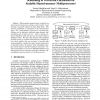Free Online Productivity Tools
i2Speak
i2Symbol
i2OCR
iTex2Img
iWeb2Print
iWeb2Shot
i2Type
iPdf2Split
iPdf2Merge
i2Bopomofo
i2Arabic
i2Style
i2Image
i2PDF
iLatex2Rtf
Sci2ools
ICPP
1996
IEEE
1996
IEEE
Scheduling of Wavefront Parallelism on Scalable Shared-memory Multiprocessors
Tiling exploits temporal reuse carried by an outer loop of a loop nest to enhance cache locality. Loop skewing is typically required to make tiling legal. This restricts parallelism to wavefronts in the tiled iteration space. For a small number of processors, wavefront parallelism can be efficiently exploited using dynamic selfscheduling with a large tile size. Such a strategy enhances intratile locality, but does not necessarily enhance intertile locality. We show that dynamic self-scheduling performs poorly on scalable shared-memory multiprocessors where smaller tiles are necessary to provide sufficient parallelism--smaller tiles place greater importance on intertile locality. We propose static scheduling strategies which enhance intertile locality for small tiles. Results of experiments on a Convex SPP1000 multiprocessor demonstrate that our strategies outperform dynamic selfscheduling by a factor of up to 2.3 on 30 processors.
Cache Locality | Distributed And Parallel Computing | Dynamic Selfscheduling | ICPP 1996 | Intertile Locality |
Related Content
| Added | 07 Aug 2010 |
| Updated | 07 Aug 2010 |
| Type | Conference |
| Year | 1996 |
| Where | ICPP |
| Authors | Naraig Manjikian, Tarek S. Abdelrahman |
Comments (0)

